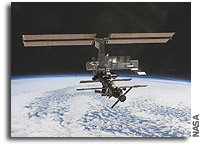ISS On-Orbit Status 20 Oct 2002
 All ISS systems continue to function nominally, except as noted previously. Ahead: Week 20 for Expedition Five.
All ISS systems continue to function nominally, except as noted previously. Ahead: Week 20 for Expedition Five.
The crew had their Sunday rest day today.
Early in the morning, before breakfast and physical exercise, CDR Valery Korzun completed his Profilaktika blood test, with Sergei Treschev assisting as CMO (crew medical officer). [At the end of the creatine kinase measurement, the results were logged and reported to a ground specialist via S-band. Later in the day, the stored data from today and the past two days were downlinked to MCC-H via Ku-band. Starting from today and through the end of Expedition 5, the cosmonauts will perform physical exercise per nominal schedule.]
CDR Korzun started his turn at the third round of the renal (kidney) stone prevention research experiment, logging his food and fluid intake. FE-2 Sergei Treschev had his second day of the regimen, which required him to collect urine samples in the course of the day besides diet logging. For FE-1/SO Peggy Whitson, sample collection ended this morning. After each collection, the sample ID is scanned and the sample then stowed.
Korzun did the regular daily checkup of the Russian BIO-5 Rasteniya-2 (“plants-2”) experiment.
Later, he completed the weekly collection of SP toilet flush and SVO water supply counter readings for calldown to the ground, and performed the daily routine maintenance on the SOSh life support system, while Whitson did the regular autonomous Lab payloads status checkup.
Peggy Whitson transferred water from the Lab condensate collection tank to a CWC (contingency water container), to relieve the filled tank.
MCC-H is looking into a request by Whitson to stow the spare P6 BMRRM (bearing motor roll ring module), brought up on 7A.1, in the Z1 vestibule, which will be cleaned out this coming week. Engineers need to determine first if there are any constraints (e.g., thermal) that would prevent its stowage there.
All crewmembers had their PFCs (private family conferences) via S- and Ku-band.
At 8:33am EDT, Whitson established a ham radio contact with several Dutch boy scout groups, assembled for a jamboree in Leylstad, Netherlands. During the ten-minute pass, the crew fielded questions from three scouting groups interested in amateur radio communications (particularly with someone in space).
Thanks to Peggy’s troubleshooting on 10/18, ARCTIC-2 health and status data has been restored after power was re-applied to the unit. Based on the knowledge gained from the troubleshooting, the ARCTIC team is modifying their procedures for troubleshooting the persistent water flow problem that will be timelined later this week.
PGBA (plant generic bioprocessing apparatus) personnel thanked Peggy for her help with the health and status data problem encountered yesterday. The problem was fixed with a power cycle (off/on). The ground wants to continue to hold off on the cable swap on the task list until further notice.
Instructions were uplinked for preparations of U.S. EVA tools for the upcoming 11A EVAs. Tasks include inventory of onboard NH3 (ammonia) vent tools and wire ties, checking and moving fluid QD (quick disconnect) tools, and rearranging stowage in the Airlock for optimal support of the spacewalks in November.
Today’s targets for the U.S. CEO (crew earth observations) program were Lower Amazon River Basin (the ISS pass was over the SE corner of this target. Crew was to try for good context views to the left of track, particularly noting the extent of the turbid, fresh water plume of the Amazon spreading into the Atlantic), Western Mediterranean Dust (a winter storm with a trailing cold front should have been entering the western Med by the time of this pass. As the station approached and crossed the Tunisian coast, the crew was to look left of track for dust clouds in the strong southerly flow in advance of the front), and Eastern Mediterranean Dust and Smog (with only oblique views available, the crew was to look to the right of track as ISS crossed lower Italy to document aerosols and smog over the Ionian Sea and the Balkan Peninsula).
ISS Orbit (as of this morning, 7:03am EDT [= epoch]):
- Mean altitude — 396.4 km
- Apogee — 406.7 km
- Perigee — 386.1 km
- Period — 92.48 min.
- Inclination (to Equator) — 51.63 deg
- Eccentricity — 0.001521
- Orbits per 24-hr. day — 15.57
- Revolutions since FGB/Zarya launch (Nov. ?98) — 22351
- Current Flight Attitude — XPOP (x-axis perpendicular to orbit plane = “sun-fixed” [yaw: -5.0, pitch: -8.6 deg., roll: 0.4 deg]),with CMG/Thruster Assist Momentum Management).
For more on ISS orbit and worldwide naked-eye visibility dates/times, see
http://www.hq.nasa.gov/osf/station/viewing/issvis.html








